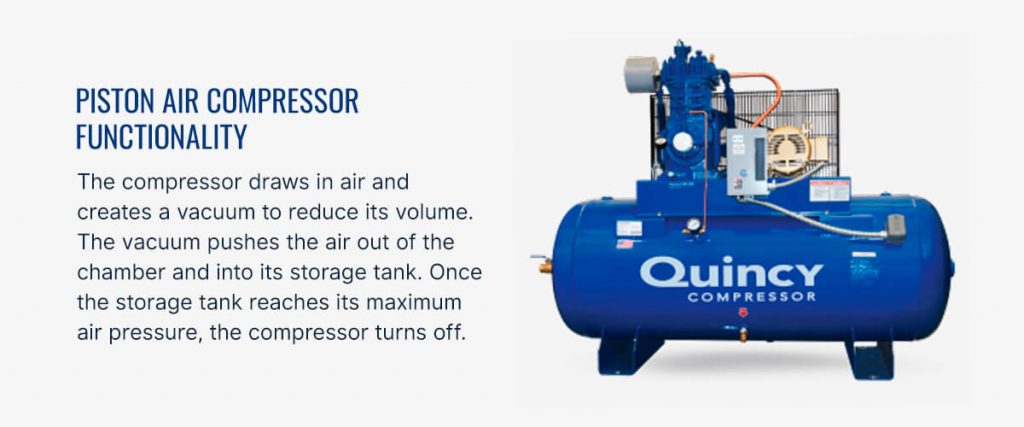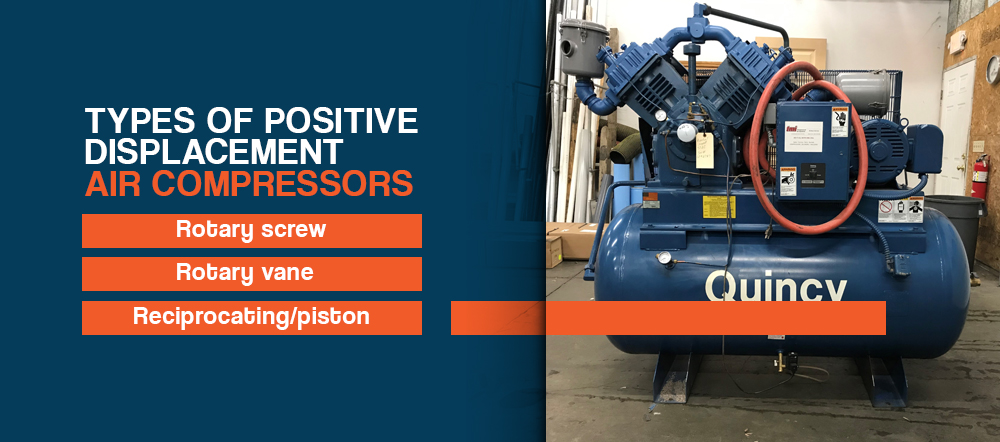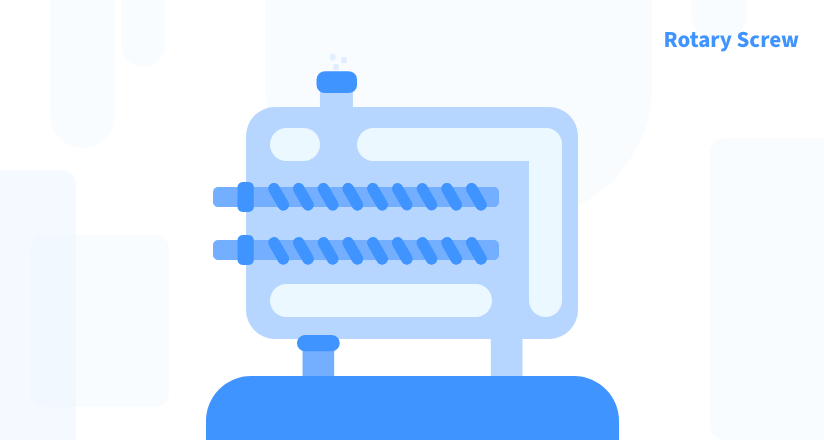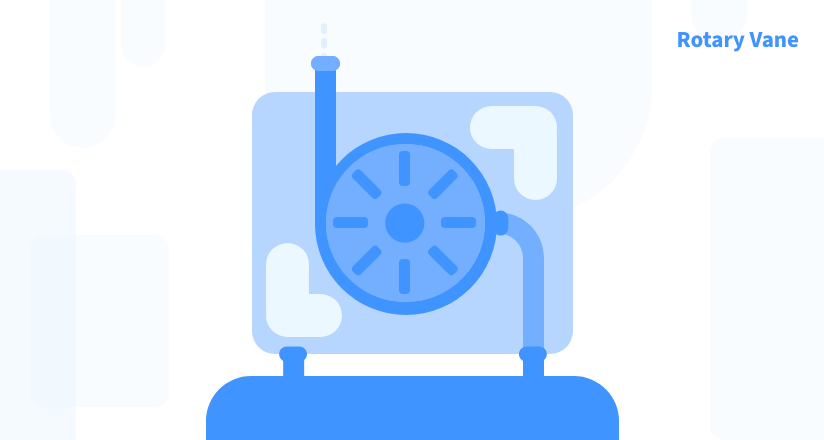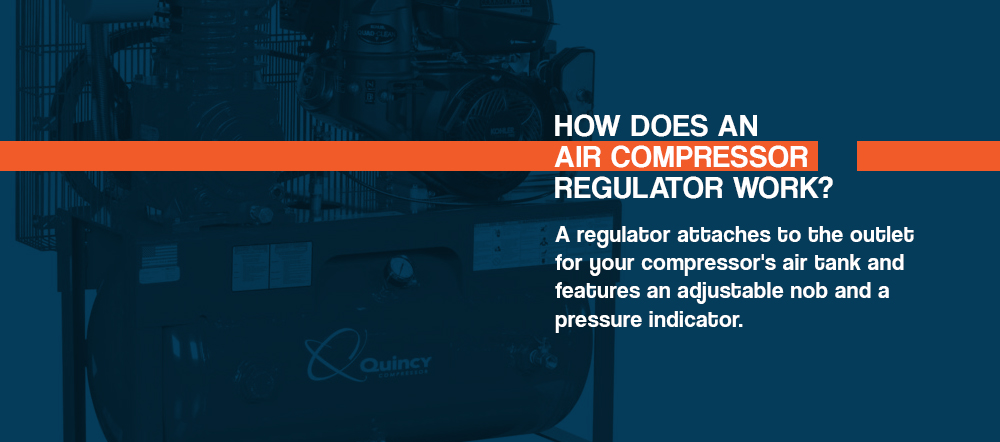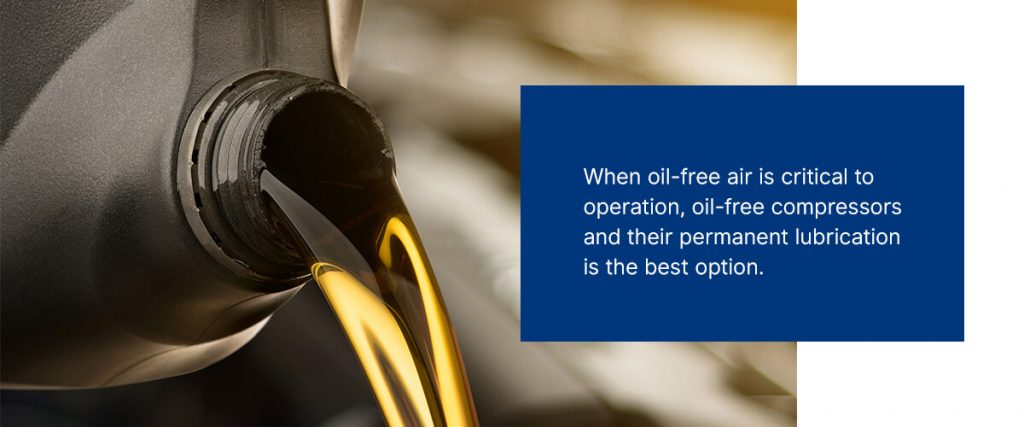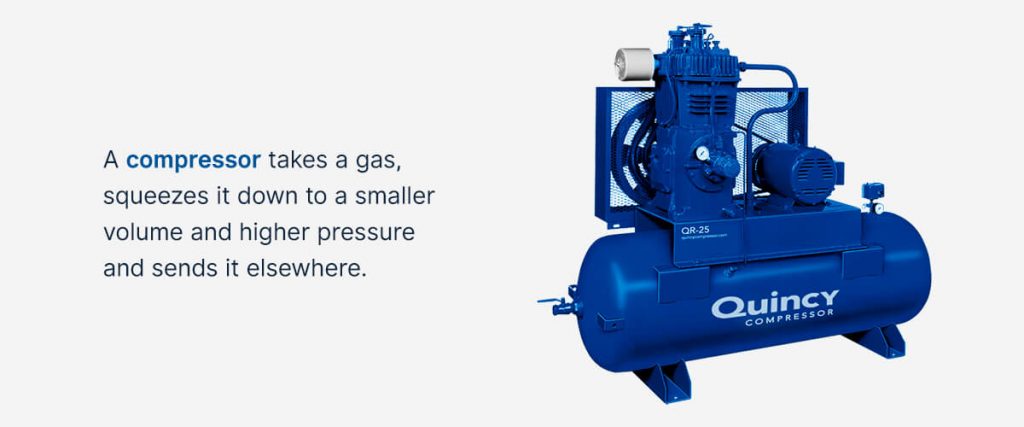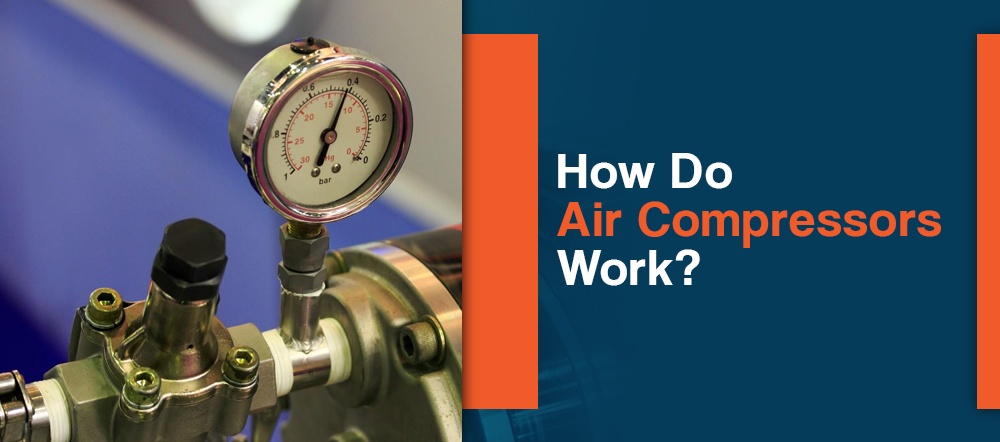
In the modern world of pneumatics, air compressors are vital to the operations of factories and workshops across the globe. But they haven’t always been. Air compressors are a relatively recent invention in the context of machine-age history.
Before air compressors, many tools got their power from complicated systems with belts, wheels and other large components. This machinery was massive, heavy and costly, and typically out of reach for many small operations. Today, air compressors come in many shapes and sizes, and you can find them in large shop floors, auto workshops and even your neighbor’s garage. In this guide, we’ll discuss how air compressors work — from their basic functionality to the various ways different compressors handle air displacement.
How Does an Air Compressor Work?
Air compressors work by forcing atmospheric air under pressure to create potential energy that can be stored in a tank for later use. Just like an open balloon, the pressure builds up when the compressed air is deliberately released, converting the potential energy into usable kinetic energy. From there, this energy transfer can be harnessed to power various pneumatic tools.
Industrial air compressors work similarly to combustion engines. Generally, air compressor operation requires a pump cylinder, piston and crankshaft to transfer energy for a wide variety of tasks. These basic components can help supply air for filling up objects like tires or inflatable pool toys, or they can supply power for operating tools such as drills, nail guns, grinders, sanders and spray guns.
From impact wrenches to AC units, many versatile air-powered tools and machines are responsible for the comfort, shelter, automation and efficiency of everyday life. The compressors themselves are more compact and lightweight than other centralized power sources. They are also long-lasting, require less maintenance and are easier to move than other old-fashioned machinery.
Piston Air Compressor Functionality
So, how does an air compressor get air? For those that use pistons, it involves two parts: Raising the pressure and reducing the volume of the air. Most compressors use reciprocating piston technology.
An air compressor typically uses:
- An electric or gas motor
- An inlet and a discharge valve to draw in and release air
- A pump to compress the air
- A storage tank
The compressor draws in air and creates a vacuum to reduce its volume. The vacuum pushes the air out of the chamber and into its storage tank. Once the storage tank reaches its maximum air pressure, the compressor turns off. This process is called the duty cycle. The compressor will turn back on when the pressure drops below a specific number.
Air compressors don’t need to have storage tanks, and a few of the smaller options forego them in favor of portability.
What Is Air Displacement?
Air displacement is at the core of each air compressor. To compress air, the internal mechanisms within the compressor move to push air through the chamber. There are two primary types of air displacement used for this purpose:
Positive displacement: Most air compressors use this method, in which air is pulled into a chamber. There, the machine reduces the volume of the chamber to compress the air. Next, it is moved into a storage tank and saved for later use.
Dynamic displacement: Also called nonpositive displacement, this method uses an impeller with rotating blades to bring air into the chamber. The energy created from the motion of the blades builds up air pressure in a shorter amount of time. Dynamic displacement can be used with turbocompressors because it works quickly and generates large volumes of air. Turbochargers in cars often use dynamic displacement air compressors.
Types of Positive Displacement Air Compressors
Because positive displacement is the more common type of air compression method, there is a large variety of positive displacement air compressors. However, each one works differently. Some are better for industrial use, and others are suitable for home projects and smaller applications. Here are some of the different types of positive displacement air compressors:
Rotary screw: A rotary screw compressor is typical for industrial use and has sizes to fit many applications. These compressors have two screws inside the motor, turning continuously in opposite directions. The motion of the screws creates a vacuum that sucks in air. That air becomes trapped between the screws’ threads and is compressed as it is forced between them. Finally, it is sent through the output or into a containment tank. Most rotary screw compressors are industrial-sized and lubricated with oil, though oil-free compressor designs are also available.
Here’s a more technical look at how oil-injected rotary screw compressors work:
- Atmospheric air enters the compressor at the inlet valve.
- The air travels through the pressure control line to the regulator valve, a process that sets the system’s air pressure.
- Air then enters the compressor, where it combines with oil into a mist.
- Air travels the length of the two internal screws as they rotate in opposite directions.
- The screw motion creates a vacuum, trapping and compressing air in the space between the screws.
- The pressurized air is forced through the output and into the primary oil separator tank while still combined with the oil as a mist.
- The centrifugal force inside the tank causes most oil molecules to form into droplets and collect at the bottom as reusable oil.
- Air then enters a secondary separation filter where more oil is removed, purifying the air further.
- The oil-free air exits the system, where it is stored in a tank or used immediately in a connected pneumatic tool or machinery.
Rotary vane: A rotary vane compressor or vacuum pump has a similar principle to a rotary screw. With a rotary vane, a motor is placed off-center inside a rounded cavity. The engine has blades with automatically adjusting arms. As the arms approach the air input, they are elongated, creating a large air cavity. As the motor spins, moving air with it, the arms approach the output and get smaller, creating a smaller space between the vanes and the round casing, which compresses the air. Vane-operated rotors are small and easy to use, making them great for homeowners and contractors.
Because of the similarity between rotary vane and rotary screw compressors, here’s a technical description of how a rotary vane air compressor functions for comparison:
- Atmospheric air enters through the inlet valve and travels into the compressor.
- Vanes are mounted on the internal spinning rotor, which is placed off-center inside the cavity.
- Arms with self-adjusting length divide the space, creating several cavities of varying size.
- Air fills the cavity and travels around, following the rotor’s rotation.
- As the cavity gets smaller, air pressure builds up and compresses the air.
- The pressurized air is then forced through the compressor’s output.
Reciprocating/piston: In a reciprocating air compressor, a rotor’s spin forces a piston to move up and down. When the piston goes down, freestanding air is pulled into a chamber. Then, the air is compressed and forced back outward as the piston rises back up. Some compressors, called single-stage compressors, use only one piston. Others, called two-stage compressors, use two pistons and are able to pressurize more air. The reciprocating type of air compressor is one of the most common.
The Mechanics of an Air Compressor
How air compressors work can vary according to design. Piston-based air compressors can have one of two types of compression cycles:
Single-stage: The piston compresses the air in one stroke. A stroke is one full rotation of the crankshaft driving the piston. The simple, single-stage design makes many of these compressors ideal for private projects.
Here are the technical steps of single-stage air compressor operation:
- The rotor’s spin forces a single piston to move up and down.
- When the piston moves down, atmospheric air is pulled into the compression chamber through the opened valve.
- When the piston moves up, the air is compressed as it’s pushed into the output chamber.
- The pressurized air is then forced through the compressor’s output.
Two-stage: The first piston compresses the air before moving it to a smaller cylinder, where another piston compresses it further. This design allows the compressor to generate higher pressures, making it ideal for factories and workshops. Since the kinetic energy that compresses air generates heat, many two-stage systems also cool air as it travels between each cylinder. Cooling the air allows the compressor to move more air without overheating.
Here’s how a two-stage air compressor operates:
- The rotor spins to control two pistons simultaneously, forcing each piston to move conversely up and down.
- The larger piston pulls air into the first compression chamber, then pushes it out to the intercooler.
- The intercooler uses a continuous stream of water to cool the air.
- The smaller piston compresses a large volume of air into a compact space, further pressurizing it.
- The pressurized air is then forced through the output by the small piston.
How Does an Air Compressor Regulator Work?
A regulator attaches to the outlet for your compressor’s air tank and features an adjustable nob and a pressure indicator. As you rotate the knob counterclockwise, it pushes on a spring which restricts a valve, which lowers the pressure by reducing the supply of air entering the regulator. When you turn the knob clockwise, the spring and the valve release, allowing more high-pressure air through the output.
For many single-stage air compressors, the preset pressure limit is 125 psi. When this limit is reached, a pressure switch goes off to stop the motor and the production of compressed air. In most operations, you don’t need to reach that pressure limit, so many compressors set air lines to a regulator. With a regulator, you can input the appropriate pressure level for a given tool.
When the amount of pressure needed to power your tool is lower than the pressure in your air pressure tank, a regulator adjusts the pressure for you. While the regulator can’t raise the pressure above what’s already in your tank, it ensures your tool gets a consistent flow of air at the correct pressure.
When the specified pressure is reached, the regulator shuts off the pump at any point in its cycle, which means the piston can be halfway through a stroke, with pressurized air in the chamber, when it stops. This air can put undue pressure on the starting circuit, which needs more power to start the motor. An unloader valve is a simple addition that releases the trapped air to avoid this problem.
A regulator is bookended by two gauges — one to monitor the pressure of the tank and another to monitor the pressure within the air line. Also, the tank has an emergency valve that triggers if the pressure switch malfunctions.
What Is a Reciprocating Piston?
The reciprocating piston involves the following parts:
- Crankshaft
- Connecting rod
- Cylinder
- Piston
- Valve head
It works similarly to a combustion engine in a car. The crankshaft rod raises the piston in the cylinder and pushes air into the compression chamber, decreasing air volume and increasing the pressure. The piston closes, forcing the compressed air into the storage tank. Then the piston opens again to draw in more air and start the process over.
Compressors that use pistons can be louder than some other designs because of how the machine’s components move and generate friction. But new technologies and advancing designs are bringing dual and multi-piston models that can make things quieter by splitting up the workload.
The Rotary Screw Air Compressor
In many heavy-duty industrial applications, a piston compressor just doesn’t cut it. For the higher pressures needed for complex pneumatic and high-powered tools, professionals tend to choose rotary screw air compressors.
While the piston air compressor uses pulsation and the alternating nature of the piston mechanic, a rotary screw compressor is continuous. A pair of rotors mesh together to pull air in and compress it as it moves through a spiral. The rotary motion moves the air through a chamber and ejects it. Fast rotational rates can minimize leakage.
Many compressor types experience some shaking, which can damage the equipment and requires you to take measure s to minimize vibrations. In contrast, most rotary screw compressors operate smoothly for even, vibration-free performance.
Rotary screw compressors can vary widely, with rates from 10 CFM to those in the 4-5 figure range. Control schemes include:
- Stop/start: This approach either provides power to the motor, or it does not, according to the application.
- Load/unload: The compressor is powered continuously, with a slide valve that reduces the tank’s capacity when a specific compression demand is met. This scheme is common in factory environments, and if it involves a stop timer, it is called a dual-control scheme.
- Modulation: Modulation also uses a sliding valve to adjust pressure by throttling/closing the inlet valve, matching the compressor’s capacity to the demand. These adjustments are less effective on rotary screw compressors than other types. Even when set to a 0 capacity, the compressor would still consume about 70 percent of its full power load. Still, modulation is applicable for operations in which frequently stopping the compressor is not an option.
- Variable displacement: This control scheme adjusts the volume of air that is pulled into the compressor. In rotary screw compressors, this method may be used alongside modulating inlet valves to improve efficiency and pressure control accuracy.
- Variable speed: Variable speed is an efficient way to control a rotary compressor’s capacity, though it may respond differently with different types of air compressors. It varies the speed of the motor, which affects the output. This equipment tends to be more delicate than other designs, so it may not suit particularly hot or dusty work environments.
How Lubrication Works in Air Compressors: Oil-Flooded vs. Oil-Free
One of the most important things to know about air compressor maintenance is how lubrication works. When you’re looking at oil pumps, you’re dealing with two categories:
- Oil-lubricated pumps: In this design, oil splashes onto walls and bearings within the cylinder. This method is also called oil-flooded lubrication and tends to be more durable. A piston ring is a piece of metal on the piston that helps to create the seal inside the combustion chamber. This ring can help keep oil out of the compressed air, but sometimes it can still seep into the tank.
- Oil-free pumps: Oil-free pumps receive special lasting lubrication that eliminates the need for oil. Oil-free pumps are an excellent option in many industries where contamination is not an option, like breweries, food production and pharmaceutical manufacturing. They ensure that no oil contaminates the air they use in their process or product.
Oil-flooded pumps are somewhat of a mixed bag. For power tools that need lubrication, the presence of oil in the air stream can be beneficial. For tools that need oil, inline sources can distribute oil in even amounts. On the other hand, many tools can stop working correctly when even minute amounts of oil are present in the air stream.
For painting or woodworking, oil can interrupt the entire process. It may keep coatings from drying or finishing evenly. Airborne oil can even corrupt the surface of wood projects.
Thankfully, there are tools to prevent oil from entering the tank, like air-line filters and oil separators. Still, when oil-free air is critical to operation, oil-free compressors and their permanent lubrication is the best option.
Air Compressor Power Ratings: What Is CFM?
When we talk about power in an air compressor, we usually speak in terms of horsepower, but there are many other ways to determine how much pressure a machine can provide. We use cubic feet per minute (CFM) to discuss the rate and volume by which a machine compresses the air. But the rate at which outside air enters the cylinder is influenced by heat, humidity and wind in the surrounding atmosphere.
To consider these internal and external factors, manufacturers use standard cubic feet per minute (SCFM), which combines CFM with those outside factors of pressure and humidity.
Another rating that you might see is displacement CFM, which looks at the efficiency of the compressor pump. It pulls information from the revolutions per minute (RPM) of the motor and the volume of air that the cylinder can displace. This number is more of a theoretical measurement, while you can also measure CFM in terms of delivered air, or how much is actually discharged. This number is called CFM FAD, which stands for free air delivery, and is useful for measuring delivery to certain tools.
Pumps vs. Compressors: Two Instruments for Harnessing Air
Some degree of confusion exists between the words “pump” and “compressor,” with many believing them to be the same thing. In reality, the distinction between the two is a crucial part of discussing air compressors:
- A pump takes liquids or gasses and moves them between places.
- A compressor takes a gas, squeezes it down to a smaller volume and higher pressure and sends it elsewhere.
The most significant distinction is that a pump can work with liquids, while a compressor cannot. Liquids are much harder to compress. You may find a pump within a compressor, such as in a reciprocating air compressor — the part that performs the compression is a pump. The functions of pumps and compressors can overlap on machines where the pressure rises with each revolution.
Take a tire pump, for example. While it happens to perform both tasks — moving air and reducing its volume — its purpose is to move outside air somewhere else, into the air-tight space of the tire. Since its goal is not to reduce the volume, it’s not technically considered a compressor. An alternative example would be using pneumatic tools, which require compressed air. The device that reduces the volume of the air is a compressor.
Air pumps generally fall into one of two categories:
- Reciprocating pumps, which move back and forth. A bicycle pump is a reciprocating pump, where the cylinder pulls outside air in with a back-and-forth motion and moves it into the tire.
- Rotary pumps, also called centrifugal pumps, which spin. A rotary pump uses an impeller, which is basically an enclosed propeller. It has blades that move incoming fluid and send it through an outlet at high speed. This pump uses motorized energy to pull fluids from one place to another, and is not to be confused with a turbine, which captures fluids that are already moving.
Compressed Air in Everyday Life
From pneumatic drills and braking systems to HVAC units, a vast range of air-powered tools and machines make everyday life comfortable, safe and efficient. In nearly every building you walk through or pass by on a given day, air tools helped someone sand the wood, paint the walls and hammer beams and plasterboards into place. On shop floors across the world, people use compressed air to add coats of paint and blast dust and debris away.
It’s nothing short of remarkable that humankind discovered a way to take ambient air, perhaps the most abundant resource on the planet, and transform it to power motorized equipment for a wide variety of purposes.
Quincy Compressor offers high-quality air compressors in many styles, including rotary screw, reciprocating/piston and oil-free. Use our sales and service locator to find a dealer near you.
Last Updated on October 22, 2021 at 3:30 pm


